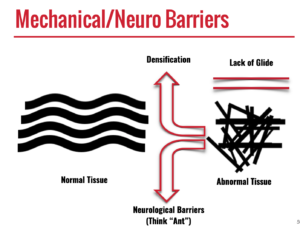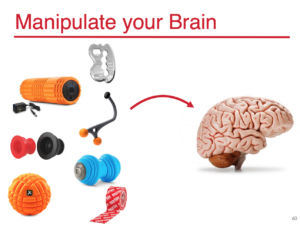by Mitch Hauschildt, MA, ATC, CSCS
A common point of discussion within live courses that I teach is this idea of fibrosis and densification. It is often a foreign concept and goes against what a lot of us were taught in school, so I understand why people are looking for clarity. First, lets look at some definitions:
Fibrosis
Fibrosis is similar to the process of scarring, with the deposition of excessive amounts of fibrous connective tissue, reflective of a reparative or reactive process.
Densification
Densification indicates an increase in the density of fascia modifying the mechanical proprieties of fascia, without altering its general structure.
What does this mean?
We typically think of disruptions to local tissue as being fibrotic tissue (or adhesions). With fibrotic tissue, we see a matrix of cells that are layered through an area in different directions and thicknesses that rarely mimic the original tissue make up.
Fibrotic tissue is easy to visualized under the skin in a lab setting, so it has been clearly identified and studied over the years. It’s association with some pain conditions and musculoskeletal dysfunction in the literature has lead many of us as clinicians to associate the painful problems that present to our facilities as directly connected to scarring and/or fibrotic tissue.
We need to understand fibrotic tissue and know that it exists. I will not deny its existence. But, it also isn’t the source of a lot of pain and certainly doesn’t explain every click, lump or catch that occurs under the skin. I would argue that not only does fibrotic tissue not explain all of our dysfunction and pain, it actually only explains a small fraction of what we see.
What’s the difference?
The definitions may seem similar, but there is a distinct difference between fibrosis and densification. The major difference between the two is the make up of the tissue. With densification, we are looking at a situation where the connective tissue between the fascial layers is thickened and “stuck”, but the actual tissue makeup itself, is still intact. With densified tissue, we still see the same mechanoreceptors, the same resilience and the same contractile properties as normal fascia.
With a fibrosis, the makeup of the tissue has been modified and it will take a lot more work to return it to some semblance of a normal tissue. Fibrotic tissue doesn’t have all of the same receptors, properties and abilities as normal fascia because it isn’t “normal” fascia. This often leads to pain and dysfunction.
What does it mean clinically?
Clinically, we need to recognize that fibrosis doesn’t occur as much as we previously thought, so we need to stop the blame game on this issue. Further, if we better understand what is going on under the skin, it will allow us to change our treatment plans to achieve better outcomes.
With regards to densification, because the tissue has the normal fascial makeup, we can influence it easily and effectively. Densified tissue will respond to varying rates, depths and types of intervention. This should be encouraging, because many of the tissue restrictions that we have previously thought of as fibrosis can now be impacted more quickly and easily than previously thought.
We have options for improving densification including providing a shear force to the area, increasing tissue temperature, stretching, or vibrating the local tissue. These are examples of ways that we can decrease the viscosity of Hyaluronic Acid (HA) in the area which will free up the local loose connective tissue and improve interlayer slide and glide.
 We can also stimulate the nervous system in the area by using massage, IASTM, vibration, or cupping to make the brain more aware of the area, which will assist in reversing the densification process.
We can also stimulate the nervous system in the area by using massage, IASTM, vibration, or cupping to make the brain more aware of the area, which will assist in reversing the densification process.
Conclusion
Some will say that the difference between fibrotic and densified tissue is not that big of a deal, but I am encouraged by understanding the difference. Fibrotic tissue is difficult, at best, to deal with. But, knowing that a lot of the stickiness and friction points that we see and feel with our patients can be impacted in a number of ways is encouraging. It explains how and why we can see quick and easy changes to local tissue. Use your tools and techniques to go after slide and glide and you will see less painful and easier movers in your practice.
- Pavan, Piero & Stecco, Antonio & Stern, Robert & Stecco, Carla. (2014). Painful Connections: Densification Versus Fibrosis of Fascia. Current pain and headache reports. 18. 441. 10.1007/s11916-014-0441-4.


Leave a Reply